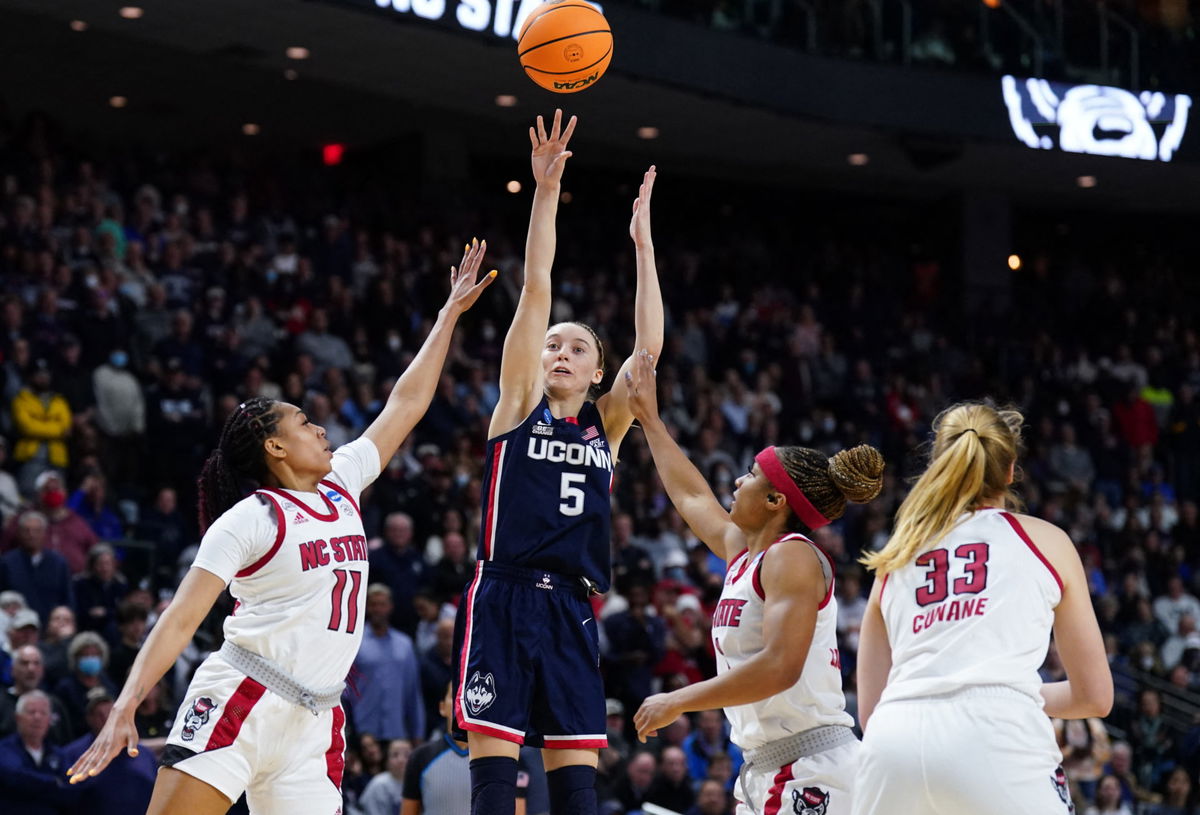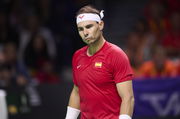
USA Today via Reuters
Mar 28, 2022; Bridgeport, CT, USA; UConn Huskies guard Paige Bueckers (5) shoots against the NC State Wolfpack during double overtime in the Bridgeport regional finals of the women’s college basketball NCAA Tournament at Webster Bank Arena. Mandatory Credit: David Butler II-USA TODAY Sports

USA Today via Reuters
Mar 28, 2022; Bridgeport, CT, USA; UConn Huskies guard Paige Bueckers (5) shoots against the NC State Wolfpack during double overtime in the Bridgeport regional finals of the women’s college basketball NCAA Tournament at Webster Bank Arena. Mandatory Credit: David Butler II-USA TODAY Sports
In the injury-stricken UConn camp, Jana El Alfy remains a mystery character. Her grounded reality highlights Huskies’ harrowing jinx. Paige Bueckers’ program in fact had a tumultuous season this year as they faced the significant setback of losing half of their players to season-ending injuries. It depleted their roster and impacted their performance.
Watch What’s Trending Now!
Players like Aubrey Griffin (torn ACL), Ayanna Patterson (patellar tendonitis), and Azzi Fudd (right ACL), sustained injuries related to the knee, while UConn’s jersey #24 Jana El Alfy suffered a pre-season injury, rupturing her Achilles tendon. Since then this Egyptian Husky has been craving to get back on the court.
ADVERTISEMENT
“She wants to play so bad”
As the daughter of the head coach of the Egyptian women’s national team, Ehab El Alfy, Jana started playing basketball at the age of 14. At that young age, she attended the NBA Junior Academy. Being able to have that accessibility became one of the major stepping stones at the beginning of her basketball career. “It’s a pivotal moment for me; my dream is to grace the WNBA,” said Jana on having the chance to practice at the academy.

USA Today via Reuters
Image Credits: USA Today
Jana’s 6’5 height along with relentless aggression in the paint, makes her a standout player for NBA coaches. Given that she was born into a basketball-centric family, she dedicatedly aspires to follow in the footsteps of the WNBA legend Diana Taurasi. In high school, she played for the Al Ahly Sporting Club. Moreover, she has been participating in the NBA Academy Women’s Program since 2019.
ADVERTISEMENT
Notably, Jana has been a member of the Egyptian National Team since 2021. Nourished under her father’s guidance, Jana proudly wore the Egyptian colors at the 2021 FIBA U16 African Championship, along with the 2022 FIBA U17 World Cup. Moreover, at the 2022 U18 African Championship, Jana led the tournament scoring 24 points and 11.5 rebounds per game earning the silver medal. Representing Egypt, her performance against New Zealand scoring 32 points and 26 rebounds with a stellar 69/47 win made her memorable in Egyptian basketball circuit.
Top Stories
NFL Files Motion to Dismiss Former Texans Board Member Cary McNair’s “Legally Baseless” Lawsuit

T.J. Watt’s Wife Shares Emotional Update on Steelers LB Following Worrying Health Scare

Forced to Leave FOX, Cowboys Legend Troy Aikman Says ESPN Is Like ‘U.S. Government’ & Clearly Distinguishes the Two Networks

New Charter Deal Triggers ‘Financial Frenzy’ as NASCAR Teams Set for Massive Payday

Steelers Legend Accuses Mike Tomlin of Lowering Standards as Winning Record Called Into Question

Rafael Nadal Faces New Injury Blow Only a Year After His Emotional Tennis Exit

In 2023, she enrolled at UConn and joined the Huskies, a late addition to the class, alongside players like KK Arnold, Ashlynn Shade, and Qadence Samuels. However, she adapted well to her new life in Connecticut, with a novel experience of snow for the first time. Unfortunately, her stint at the 2023 FIBA U19 Women’s Basketball World Cup in Spain didn’t turn out well as she painfully ruptured her Achilles tendon, hence, sidelining her for the whole season. In the World Cup though, she scored 21.4 points and 11 rebounds and attained 4th rank in the tournament.
ADVERTISEMENT
Having been in recovery for the past eight months now, Jana craves to play as essentially as breathing. She has been participating in the pregame warmups, dressed in partial uniform and looking razor-sharp out on the court. “She has no life other than rehab because she wants to play so bad,” said UConn head coach Geno Auriemma.
Read More: Cameron Brink Admits Not Knowing Paige Bueckers’ Pronunciation During Hilarious Stanford Stroll
Notably, Jana also participated in UConn’s full warm-ups in both the quarterfinals and semifinals of the Big East Tournament, jumping, sprinting, and shooting the ball with ease, however, hesitating in cutting (given the importance of Achilies in these movements).
ADVERTISEMENT
The Achilles anatomy
As the thickest and strongest tendon in the human body, the Achilles tendon is a very strong band-like tissue that gives us the ability to jump, pivot, cut, and sprint. Notably, when a player jumps to make a rebound, or goes for a layup, or attempts to make a dunk, the energy stored in the Achilles tendon gets released and propels them upward.
Similarly, during cuts, the Achilles tendon allows a player to push off the ground forcefully. The tendon also provides stability and power while evading defenders or making sharp turns. Moreover, when a player is sprinting down the court, the tendon facilitates rapid push-offs that enable acceleration.
ADVERTISEMENT
However, several risk factors in these movements can result in injury. Overuse and sudden or forceful movements can put a strain on the Achilles tendon. That’s why older athletes are more prone to sustain this injury. Along with that, previous injuries and intense activity levels can also contribute to the unfortunate result.
Hence, wearing proper footwear is essential. Moreover, regular stretching and strengthening exercises help in maintaining the tendon’s health, so warm-ups before practice give better protection against injury.
ADVERTISEMENT
ADVERTISEMENT
ADVERTISEMENT

